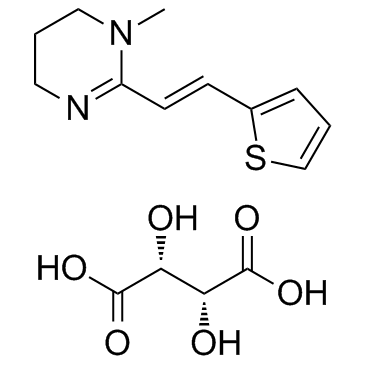Pyrantel tartrate

Pyrantel tartrate structure
|
Common Name | Pyrantel tartrate | ||
|---|---|---|---|---|
| CAS Number | 33401-94-4 | Molecular Weight | 356.39400 | |
| Density | N/A | Boiling Point | 324.4ºC at 760 mmHg | |
| Molecular Formula | C15H20N2O6S | Melting Point | 148-150ºC | |
| MSDS | Chinese USA | Flash Point | 150ºC | |
| Symbol |

GHS06 |
Signal Word | Danger | |
Use of Pyrantel tartratePyrantel tartrate is an antinematodal thiophene; nicotinic receptor agonist and can elicit spastic muscle paralysis in parasitic worms due to prolonged activation of the excitatory nicotinic acetylcholine (nACh) receptors on body wall muscle. |
| Name | pyrantel tartrate salt |
|---|---|
| Synonym | More Synonyms |
| Description | Pyrantel tartrate is an antinematodal thiophene; nicotinic receptor agonist and can elicit spastic muscle paralysis in parasitic worms due to prolonged activation of the excitatory nicotinic acetylcholine (nACh) receptors on body wall muscle. |
|---|---|
| Related Catalog | |
| References |
| Boiling Point | 324.4ºC at 760 mmHg |
|---|---|
| Melting Point | 148-150ºC |
| Molecular Formula | C15H20N2O6S |
| Molecular Weight | 356.39400 |
| Flash Point | 150ºC |
| Exact Mass | 356.10400 |
| PSA | 158.90000 |
| InChIKey | VWRCYAZJKNPEQR-NIEARKAZSA-N |
| SMILES | CN1CCCN=C1C=Cc1cccs1.O=C(O)C(O)C(O)C(=O)O |
| Storage condition | 2-8℃ |
| Water Solubility | H2O: soluble4.0ML, clear, colorless to faint yellow or tan (Solvent: 200 mg plus 4.0 mL ) |
CHEMICAL IDENTIFICATION
HEALTH HAZARD DATAACUTE TOXICITY DATA
|
| Symbol |

GHS06 |
|---|---|
| Signal Word | Danger |
| Hazard Statements | H301 |
| Precautionary Statements | P301 + P310 |
| Personal Protective Equipment | Eyeshields;Faceshields;Gloves;type P2 (EN 143) respirator cartridges |
| Hazard Codes | T |
| Risk Phrases | R25 |
| Safety Phrases | 45 |
| RIDADR | UN 2811 6.1/PG 3 |
| WGK Germany | 3 |
| RTECS | UW0249000 |
| Packaging Group | III |
| Hazard Class | 6.1(b) |
|
Evaluation of pyrantel-tartrate abbreviated Ascaris suum infections for the development of resistance in young pigs against migrating larvae.
Int. J. Parasitol. 20(1) , 77-81, (1990) Crossbred young pigs were used to test whether abbreviated infections with eggs of Ascaris suum can stimulate the acquisition of resistance to challenge. Weanling pigs from an Ascaris-free colony were... |
|
|
Concurrent infections with the ruminant nematodes Haemonchus contortus and Trichostrongylus colubriformis in jirds, Meriones unguiculatus, and use of this model for anthelmintic studies.
J. Parasitol. 77(4) , 621-3, (1991) Haemonchus contortus- and Trichostrongylus colubriformis-infected jirds (Meriones unguiculatus) are useful for anthelmintic studies. With concurrent infections of these parasites established in the ji... |
|
|
Pyrantel pamoate resistance in horses receiving daily administration of pyrantel tartrate.
J. Am. Vet. Med. Assoc. 228(1) , 101-3, (2006) 16 horses treated daily with pyrantel tartrate (2.64 mg/kg [1.2 mg/lb], PO) as part of a prophylactic anthelmintic program.Fecal worm egg counts (FWECs) were obtained on all 16 horses. Mean FWEC was 4... |
| Pyrantel tartrate |
| Pyranteltartrat |
| Pyrantel (+)-tartrate salt |
| Pyrantel Tartate |
| 1-Methyl-2-(2-[2-thienyl]ethenyl)-1,4,5,6-tetrahydropyrimidine |
| pyrantel hydrogen tartrate |
| Pyrantel (tartrate) |